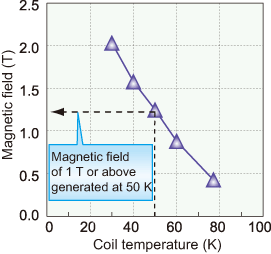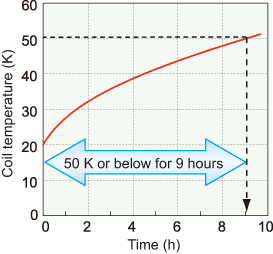5. Small scale superconducting magnet using 2nd-generation high-temperature superconducting wire
- RTRI manufactured a high-temperature superconducting coil that can generate a magnetic field of 1 T at 50 K.
- It also developed a high-performance cryostat that can keep the coil below 50 K for nine hours without a cryocooler.
- The above was used to develop a small scale superconducting magnet that can generate a magnetic field of 1 T for long periods.
RTRI is currently studying the application of yttrium-based high-temperature superconducting wire, whose performance has recently been significantly improved, to superconducting magnets for maglev trains. Since these wires can be used at higher temperatures than their conventional niobium titanium wire, they offer the advantage of reducing cost, weight and electric power consumption of cryocoolers. This design study demonstrated that these merits are maximized when the superconducting magnet is used at about 50 K (Kelvin: unit of absolute temperature).
Accordingly, a high-temperature superconducting coil using yttrium-based wire was manufactured, and a small scale superconducting magnet was produced that can maintain a magnetic field of 1 T (Tesla: unit of magnetism) for long periods – even if the excitation power supply and the cryocooler are separated – by keeping it in a high-performance cryostat capable of long-term cold storage (Fig. 1). This magnet can generate a magnetic field of 1 T at a coil temperature of 50 K (the same order as that of superconducting magnets for actual superconducting magnets) (Fig. 2), and is capable of maintaining a field of 0.5 T or above for five hours. RTRI also developed a high-performance cryostat capable of cold storage for long periods utilizing the heat capacity of metal by arranging it around the coil, and confirmed that it has the cold storage capacity to keep the coil temperature at 50 K or below for nine hours (Fig. 3).
 Fig. 1 Small scale superconducting magnet
Fig. 1 Small scale superconducting magnet Fig. 2 Magnetic field performance
Fig. 2 Magnetic field performance Fig. 3 Cold storage capacity
Fig. 3 Cold storage capacity